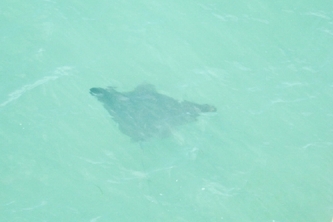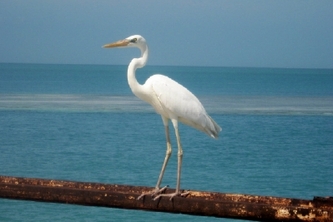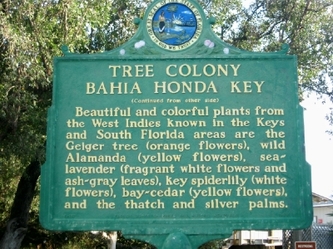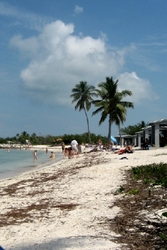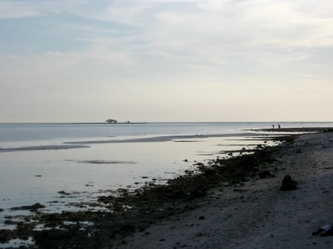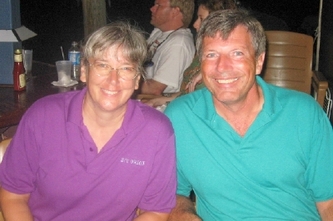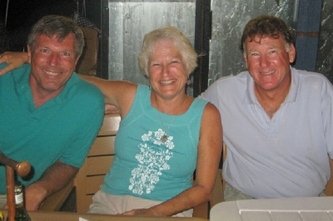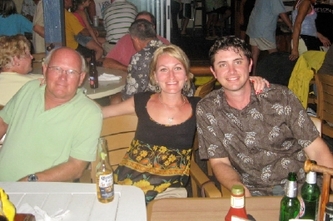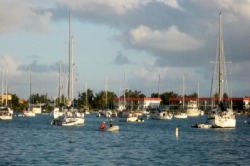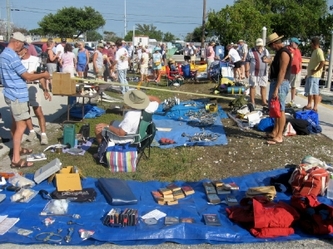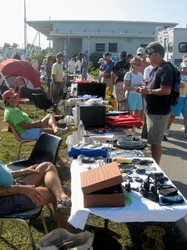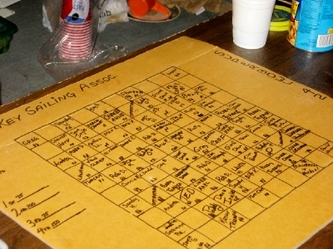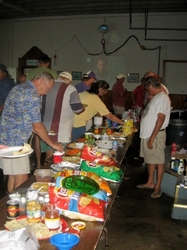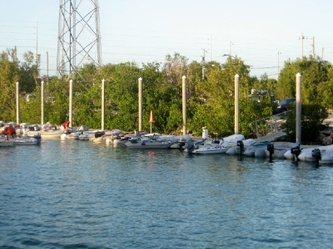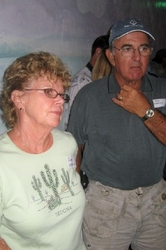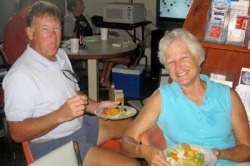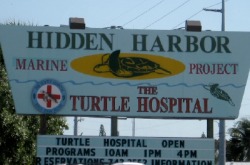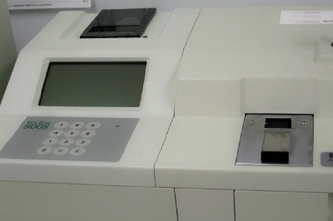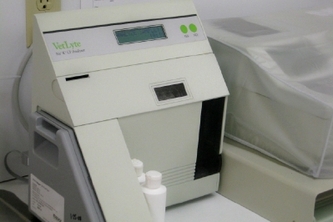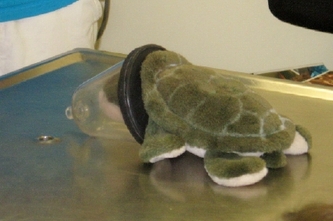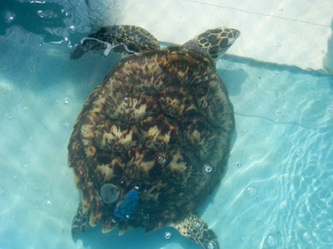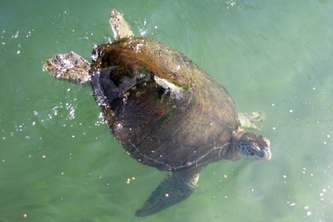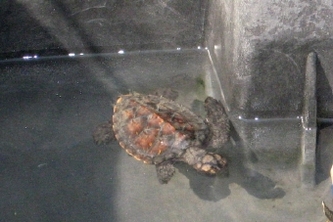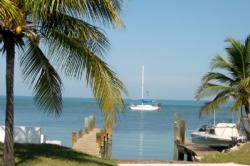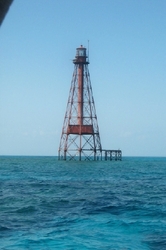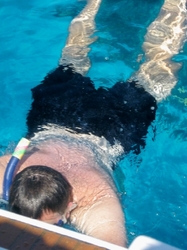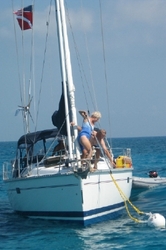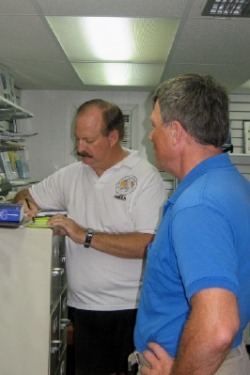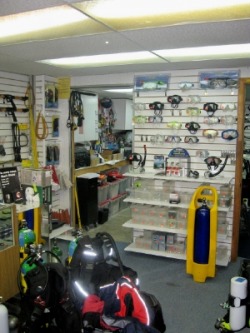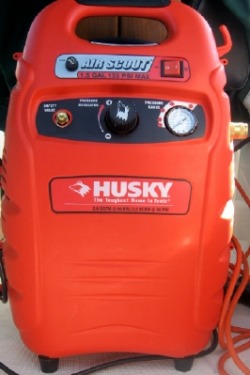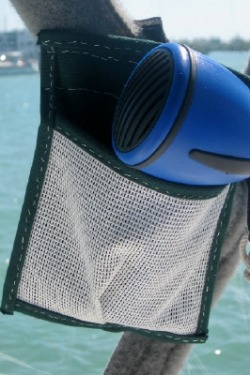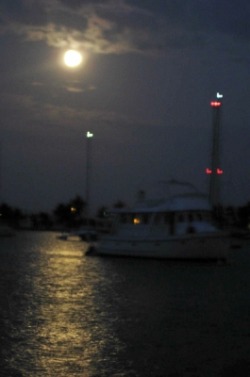
Moonlight over Boot Key Harbor
Our short stay in Marathon has extended to a month with several more weeks likely before we leave here. The time moves faster than we realize, and we continue to enjoy being here among friends.
Throw me a line
The night before we were originally planning to leave Marathon, we met Barb and Dave from Fortunate and Tom and Cathie from Interlude for an evening of 25cent wings at Hurricane’s. We said our goodbyes at the dinghy dock, and then parted company, as Dave and I headed to take a shower before returning to the boat. We were in for a rude surprise as Dave tried to crank up our usually reliable dinghy outboard for the trip back to the boat. Instead of 1 or 2 pulls, the engine wasn’t starting after 5 – 10 – 15 pulls. Dave’s arm was starting to hurt and our prospects of making it back to the boat were getting pretty slim, given the sparsely populated dinghy dock. It was with some relief that we were once again the beneficiaries of the kindness of strangers.
Another boater saw our problems and offered to tow us back to our mooring. Since we were at the farthest part of the mooring field, we double-checked to see if they were still willing to offer assistance. They didn’t hesitate. We threw them a line and gratefully tethered ourselves to our rescuers, who safely delivered us to our mooring and then made the long trek in the dark back to theirs.
It was not a good sign for leaving in the morning. Without a reliable working dinghy, we could easily be stranded ashore or on the boat. That was not a comfortable feeling. At least, in Marathon, we had friends to help us diagnose the problem or help with a ride, if we were stuck again. We decided that our planned departure was premature.
After working with Tom on Interlude, who helped Dave change the spark plug and disassemble and clean the carburetor, Dave thought the problem might be resolved. It wasn’t long before the outboard failed to start again. We decided to take the advice of the locals and call Eric at Inflatable Boats, who has been highly praised for his outboard maintenance knowledge. He quickly diagnosed the problem as being related to the fuel we had added the night before, while in route into the dinghy dock for dinner. There was likely water in it. So, we just needed to run it out of the engine, wipe the fuel tank clean and refill with good fuel.
After following his advice, the engine began starting reliably, until we added more gas that we had obtained from the same gas station. We had dinghied to the opposite end of the harbor, only to discover we were about as far from our boat as we could be with an engine that wouldn’t start. However, the wind was strong and blowing us toward the boat, so we broke out the oars and simply drifted back to the boat with a few strokes of the oars to keep us in the right direction.
We now had pretty strong evidence that the gas station’s gas was the source of the problem, so we took all that we had left to shore to be recycled and refilled with gas from another source. We’ve had no problems since. However, we have seen many dinghies being towed or having trouble starting that we’re pretty sure is related to the water in the gas from the same station.
Throw me a line
The night before we were originally planning to leave Marathon, we met Barb and Dave from Fortunate and Tom and Cathie from Interlude for an evening of 25cent wings at Hurricane’s. We said our goodbyes at the dinghy dock, and then parted company, as Dave and I headed to take a shower before returning to the boat. We were in for a rude surprise as Dave tried to crank up our usually reliable dinghy outboard for the trip back to the boat. Instead of 1 or 2 pulls, the engine wasn’t starting after 5 – 10 – 15 pulls. Dave’s arm was starting to hurt and our prospects of making it back to the boat were getting pretty slim, given the sparsely populated dinghy dock. It was with some relief that we were once again the beneficiaries of the kindness of strangers.
Another boater saw our problems and offered to tow us back to our mooring. Since we were at the farthest part of the mooring field, we double-checked to see if they were still willing to offer assistance. They didn’t hesitate. We threw them a line and gratefully tethered ourselves to our rescuers, who safely delivered us to our mooring and then made the long trek in the dark back to theirs.
It was not a good sign for leaving in the morning. Without a reliable working dinghy, we could easily be stranded ashore or on the boat. That was not a comfortable feeling. At least, in Marathon, we had friends to help us diagnose the problem or help with a ride, if we were stuck again. We decided that our planned departure was premature.
After working with Tom on Interlude, who helped Dave change the spark plug and disassemble and clean the carburetor, Dave thought the problem might be resolved. It wasn’t long before the outboard failed to start again. We decided to take the advice of the locals and call Eric at Inflatable Boats, who has been highly praised for his outboard maintenance knowledge. He quickly diagnosed the problem as being related to the fuel we had added the night before, while in route into the dinghy dock for dinner. There was likely water in it. So, we just needed to run it out of the engine, wipe the fuel tank clean and refill with good fuel.
After following his advice, the engine began starting reliably, until we added more gas that we had obtained from the same gas station. We had dinghied to the opposite end of the harbor, only to discover we were about as far from our boat as we could be with an engine that wouldn’t start. However, the wind was strong and blowing us toward the boat, so we broke out the oars and simply drifted back to the boat with a few strokes of the oars to keep us in the right direction.
We now had pretty strong evidence that the gas station’s gas was the source of the problem, so we took all that we had left to shore to be recycled and refilled with gas from another source. We’ve had no problems since. However, we have seen many dinghies being towed or having trouble starting that we’re pretty sure is related to the water in the gas from the same station.
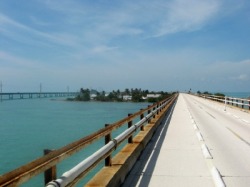
Looking west toward Pigeon Key on 7-mile Bridge
Seven Mile Bridge
Back in the early part of the twentieth century, Henry Flagler began to extend his vision of a railroad that would run throughout Florida to include the Florida Keys. Of the many engineering challenges involved in completing this line, one of the most difficult was spanning Moser Channel between Vaca Key and Big Pine Key, close to a seven mile distance. Despite the challenges of heat, mosquitos, hurricanes and the vast expanse of water, the bridge was eventually completed to enable the railroad to run all the way to Key West. This new transportation link dramatically changed the economy and character of the islands. It lasted only a short time before a hurricane destroyed the railroad. The bridges were renovated in the 30’s as roadways for car traffic. Then, in the 80’s, a more modern, wider and safer bridge was built to replace Flagler’s original span. Rather than tear down the historic bridge, sections were removed to prevent car traffic and allow boat traffic through the opening.
Back in the early part of the twentieth century, Henry Flagler began to extend his vision of a railroad that would run throughout Florida to include the Florida Keys. Of the many engineering challenges involved in completing this line, one of the most difficult was spanning Moser Channel between Vaca Key and Big Pine Key, close to a seven mile distance. Despite the challenges of heat, mosquitos, hurricanes and the vast expanse of water, the bridge was eventually completed to enable the railroad to run all the way to Key West. This new transportation link dramatically changed the economy and character of the islands. It lasted only a short time before a hurricane destroyed the railroad. The bridges were renovated in the 30’s as roadways for car traffic. Then, in the 80’s, a more modern, wider and safer bridge was built to replace Flagler’s original span. Rather than tear down the historic bridge, sections were removed to prevent car traffic and allow boat traffic through the opening.
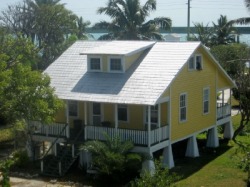
Pigeon Key Guest Quarters
The first 2 mile section of the old bridge, heading west from Vaca Key, leads to the tiny Pigeon Key, originally a construction camp for the bridgeworkers and now an historic site. This span is available for walkers to enjoy the view of the waters of the Gulf of Mexico on the North and the Atlantic Ocean to the south. It is an excellent viewing spot for sea turtles and manta rays, pelicans and egrets. We saw several examples of each as we made our way to and from Pigeon Key along the span one morning.
The old bridge has a more recent claim to fame, as well. It was used in the movie, True Lies, as the location for a dramatic chase scene, complete with limousines, helicopters, and Navy jets. The bridge is “destroyed” in the movie. It was very convenient that the gaps had already been created before the movie was made.
Bahia Honda
Bahia Honda
As a heat wave caused the winds to die and the heat to soar, we headed out of Boot Key Harbor for (hopefully) a cooler night at anchorage in Bahia Honda, about 15 miles west of Marathon, with our friends Joy and Rusty on Slow Dancin’. Bahia Honda means “deep bay”, which is a little curious, since the depths in the anchorage were generally much less than 15 feet. At any rate, it was cooler than Boot Key, and gave us a chance to go in the water, which was clear and calm. Shortly after dropping anchor. Rusty got in the water to check out his anchor and then swam over to look at ours for us. It looked like it would be a good place to clean the bottom of the boat.
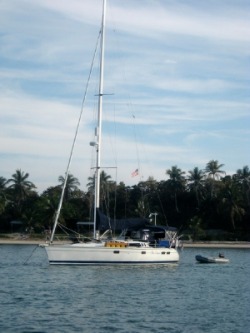
Slow Dancin and Orion anchored in Bahia Honda
After eating lunch, we hauled the compressor out and Dave got in the water. What we didn’t realize was that in the intervening hour and a half, we had changed from slack tide to a fast-running ebb current. The guidebooks say that Bahia Honda has some of the fastest running current in the Keys. Dave learned this the hard way, since it was all he could do to hold onto the boat and still try to clean it. We strung dock lines off the cleats and he used this to hold his position. By the time he was done, he was exhausted, but the bottom and the thru-hulls were clean. Cathy got in the water briefly to cool off, but the current was still so strong that swimming was not an option.
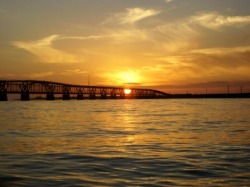
The anchorage at Bahia Honda is between the old railroad bridge, seen here and a new bridge that carries the car traffic to Key West.
Once the sun set, the air cooled enough that we could sleep. The next morning, as we were about to pull anchor to head back, we saw Barb and Dave from Fortunate on the shore with their daughter and son-in-law. They had driven down for a swim, and we dinghied ashore to join them for a few hours before heading out.
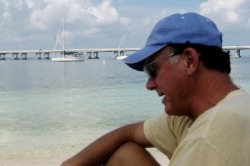
Rusty on beach with Orion in the background
In the heat and humidity, every effort, no matter how mild was exhausting and caused us to be drenched in sweat. We were looking forward to getting underway and generating a breeze to cool off. Unfortunately, we had barely cleared the bridge that marked the entrance to the anchorage, when Dave told Cathy to keep the rpm’s low, since the raw water strainer appeared to be low on water. Thinking the problem was caused by the efforts to clean out the thru-hulls the day before, Dave decided we needed to re-anchor and look under the boat. We pulled toward shallow water on the outer side of Bahia Honda Key.
Although we were now in a more exposed body of water, the light winds made the sea very calm, so we felt reasonably comfortable attempting to raft to Slow Dancin’. However, the swells were more than the 2 boats could manage in such close quarters. We had been rafted only minutes, when a swell started rocking us violently and ended up in a broken stanchion on Orion. We quickly separated, and anchored separately. Rusty came over in his dinghy and helped Dave diagnose the problem.
They attempted to clear the blockage from within the engine compartment. After restarting the engine, the pressure seemed to have been restored without the need to dive on the boat. We declared victory and slowly got underway again. As we gradually took it to full speed, we had no more problems with the raw water level. It appeared the problem had been resolved. We just had to take care of that stanchion which was now bent 90 degrees and looked pretty sad.
It’s always something.
Boat Stuff
Dave called the parts department at Beneteau USA and was quickly shipped a replacement stanchion for the one damaged in our failed rafting attempt. At first glance, replacing the stanchion seemed straightforward. We simply had to remove the lifelines, release the bolt holding the existing stanchion, attach the new stanchion and restring the lifelines.
Nothing is as easy as it looks.
The old stanchion came off easy enough, but it left behind a collar that had been crimped in place on the lifeline by the violent bend of the stanchion. This would have to be removed before it could be threaded through the new stanchion. Also, the lower lifeline’s endbolt would not turn freely within the sleeve that attached it to the bow rail. We managed to get it off, but getting back on may not be so easy. Finally, the base of the stanchion, which was undamaged by the collision, was a little loose and would need to be tightened. Access to this was going to have to be made from within the cabin.
Our first project was working to get the old collar off the lifeline. Since this was pretty strong stainless steel, simply prying it open with pliers was not going to work. Dave had to use his jigsaw to weaken the metal enough to open it up so that it would slide off. Next, we had to remove some of the interior wood in the cabin below to get access to the stanchion base. Once this was tightened, we started to work on the frozen lifeline bolt. When we were unable to free it, we simply did our best to create the right tension with the amount of threads available to us and found the results satisfactory.
The new stanchion looks great!
What’s The Weather?
The heat wave was due to break by mid-week the last week of February. In the meantime, the heat was taking its toll on Cathy’s eczema. She decided to hunker down in the air conditioning of the Marathon library until the cold front came through. This allowed a cool environment, with access to a computer and the internet. On the 2nd day of this self-imposed therapy, we were surprised when the power went out shortly after 1pm. The power was restored within about 15 minutes, but we were to learn later that we were part of a massive power outage that affected almost all of Florida. Miami was most affected, with people still without power that evening. The local power plant (right next to the Marathon marina) was using the full complement of its diesel generators to generate power, backing up the power plants that were offline further north. Little did we know that our minor inconvenience was part of a bigger event statewide.
The winds finally started to blow Tuesday night and the cooler weather arrived overnight, bringing welcome relief from the heat.
Although we were now in a more exposed body of water, the light winds made the sea very calm, so we felt reasonably comfortable attempting to raft to Slow Dancin’. However, the swells were more than the 2 boats could manage in such close quarters. We had been rafted only minutes, when a swell started rocking us violently and ended up in a broken stanchion on Orion. We quickly separated, and anchored separately. Rusty came over in his dinghy and helped Dave diagnose the problem.
They attempted to clear the blockage from within the engine compartment. After restarting the engine, the pressure seemed to have been restored without the need to dive on the boat. We declared victory and slowly got underway again. As we gradually took it to full speed, we had no more problems with the raw water level. It appeared the problem had been resolved. We just had to take care of that stanchion which was now bent 90 degrees and looked pretty sad.
It’s always something.
Boat Stuff
Dave called the parts department at Beneteau USA and was quickly shipped a replacement stanchion for the one damaged in our failed rafting attempt. At first glance, replacing the stanchion seemed straightforward. We simply had to remove the lifelines, release the bolt holding the existing stanchion, attach the new stanchion and restring the lifelines.
Nothing is as easy as it looks.
The old stanchion came off easy enough, but it left behind a collar that had been crimped in place on the lifeline by the violent bend of the stanchion. This would have to be removed before it could be threaded through the new stanchion. Also, the lower lifeline’s endbolt would not turn freely within the sleeve that attached it to the bow rail. We managed to get it off, but getting back on may not be so easy. Finally, the base of the stanchion, which was undamaged by the collision, was a little loose and would need to be tightened. Access to this was going to have to be made from within the cabin.
Our first project was working to get the old collar off the lifeline. Since this was pretty strong stainless steel, simply prying it open with pliers was not going to work. Dave had to use his jigsaw to weaken the metal enough to open it up so that it would slide off. Next, we had to remove some of the interior wood in the cabin below to get access to the stanchion base. Once this was tightened, we started to work on the frozen lifeline bolt. When we were unable to free it, we simply did our best to create the right tension with the amount of threads available to us and found the results satisfactory.
The new stanchion looks great!
What’s The Weather?
The heat wave was due to break by mid-week the last week of February. In the meantime, the heat was taking its toll on Cathy’s eczema. She decided to hunker down in the air conditioning of the Marathon library until the cold front came through. This allowed a cool environment, with access to a computer and the internet. On the 2nd day of this self-imposed therapy, we were surprised when the power went out shortly after 1pm. The power was restored within about 15 minutes, but we were to learn later that we were part of a massive power outage that affected almost all of Florida. Miami was most affected, with people still without power that evening. The local power plant (right next to the Marathon marina) was using the full complement of its diesel generators to generate power, backing up the power plants that were offline further north. Little did we know that our minor inconvenience was part of a bigger event statewide.
The winds finally started to blow Tuesday night and the cooler weather arrived overnight, bringing welcome relief from the heat.
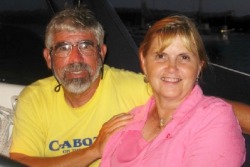
Tom and Cathie on their last night in Boot Key Harbor
Food and Friends
Amid the many visits on each others’ boats, we said goodbye to Tom and Cathie on Interlude, who left for the Bahamas on the morning of the 22nd. We saw them off with a homemade key lime pie made by another cruiser. It was delicious.
One Sunday morning, we visited the American Legion for their Sunday breakfast and met some fellow cruisers who were also in the harbor near us. As a thank you to Ray and Susan on Turtle who gave us a tow on our dinghy, we had them over for dinner one evening and got to meet one of their pet iguanas, who also came for the visit. So much for the usual dog or cat on board.
Amid the many visits on each others’ boats, we said goodbye to Tom and Cathie on Interlude, who left for the Bahamas on the morning of the 22nd. We saw them off with a homemade key lime pie made by another cruiser. It was delicious.
One Sunday morning, we visited the American Legion for their Sunday breakfast and met some fellow cruisers who were also in the harbor near us. As a thank you to Ray and Susan on Turtle who gave us a tow on our dinghy, we had them over for dinner one evening and got to meet one of their pet iguanas, who also came for the visit. So much for the usual dog or cat on board.
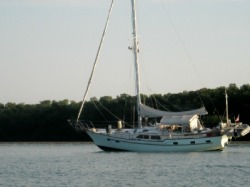
Boat aground just outside the mooring field
It’s a Marathon visit
Marathon claims to be the friendliest harbor in the world, which is a lot of the reason why our stay here has been so long. We will probably be here now through most of March, with the possible exception of a trip to the Dry Tortugas. In the meantime, we continue to enjoy it here.
Marathon claims to be the friendliest harbor in the world, which is a lot of the reason why our stay here has been so long. We will probably be here now through most of March, with the possible exception of a trip to the Dry Tortugas. In the meantime, we continue to enjoy it here.
